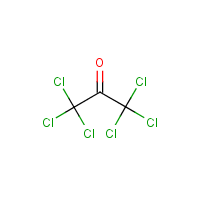Hexachloroacetone
Agent Name
Hexachloroacetone
CAS Number
116-16-5
Formula
C3-Cl6-O
Major Category
Other Classes

Synonyms
1,1,1,3,3,3-Hexachloro-2-propanone; 1,1,1,3,3,3-Hexachloropropanone; 2-Propanone, 1,1,1,3,3,3-hexachloro-; 2-Propanone, hexachloro-; Acetone, hexachloro-; Bis(trichloromethyl) ketone; GC-1106; HCA; HCA (VAN); HCA weedkiller; Hexachloro-2-propanone; Hexachloropropanone; Kureha HCA; Perchloro-2-propanone; Perchloroacetone; [ChemIDplus] UN2661
Category
Halogenated Ketones
Description
Yellow liquid; [Hawley]
Sources/Uses
Used as reagent for N-trichloroacetylation of dipeptides, to produce chloroform, and formerly as a herbicide and pre-harvest desiccant on alfalfa seed crops; [HSDB]
Comments
Highly irritating; Produces phosgene when heated; [Hawley] A skin and mucous membrane irritant; A mild lachrymator; Oral LD50 (rat) = 1550 mg/kg; In animal studies, caused pulmonary edema after inhalation and liver and kidney injury after ingestion; Can cause burns of skin and eyes; [HSDB] Oral TDLo (rat) = 450.8 mg/kg (1-14D preg) for maternal effects (oogenesis); [RTECS] Contact with molten substance may cause severe burns; [CAMEO] An irritant; Effects in high-dose animal studies include pulmonary edema; [MSDSonline]
Biomedical References
Exposure Assessment
Vapor Pressure
0.123 mm Hg
Lethal Concentration
LC50 (rat) = 360 ppm/6h
Explanatory Notes
VP from ChemIDplus;
Adverse Effects
Lachrymator
Yes
Toxic Pneumonitis
Yes
Hepatotoxin
Hepatoxic (a) from occupational exposure (secondary effect) or (b) in animal studies or in humans after ingestion
Reproductive Toxin
Yes
Dermatotoxin
Skin burns
Diseases, Processes, and Activities Linked to This Agent
Processes
Industrial Processes with risk of exposure: